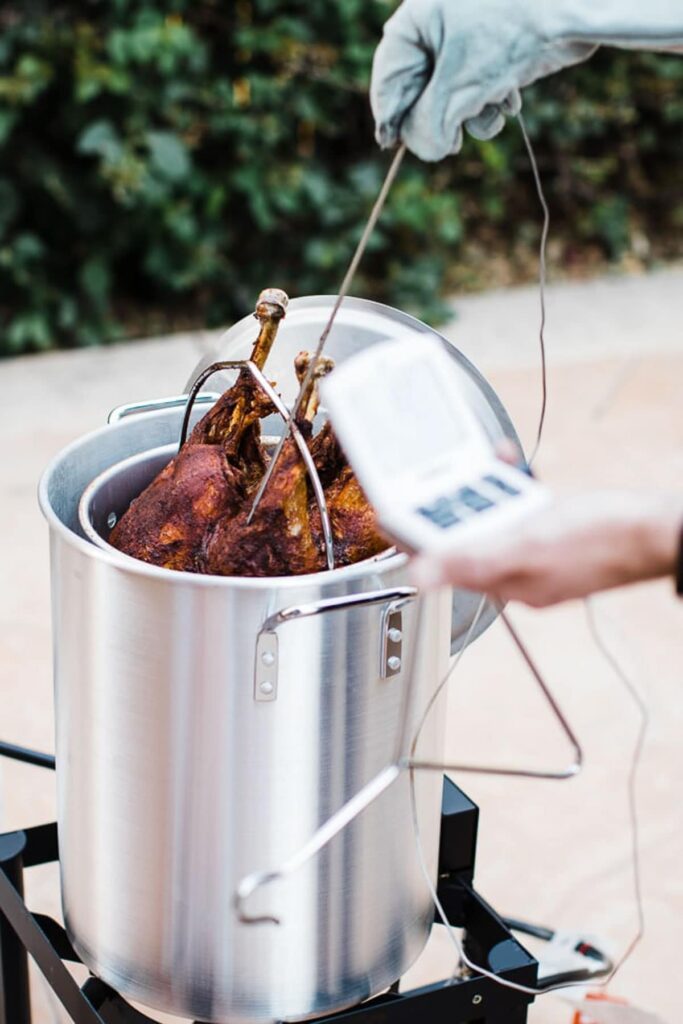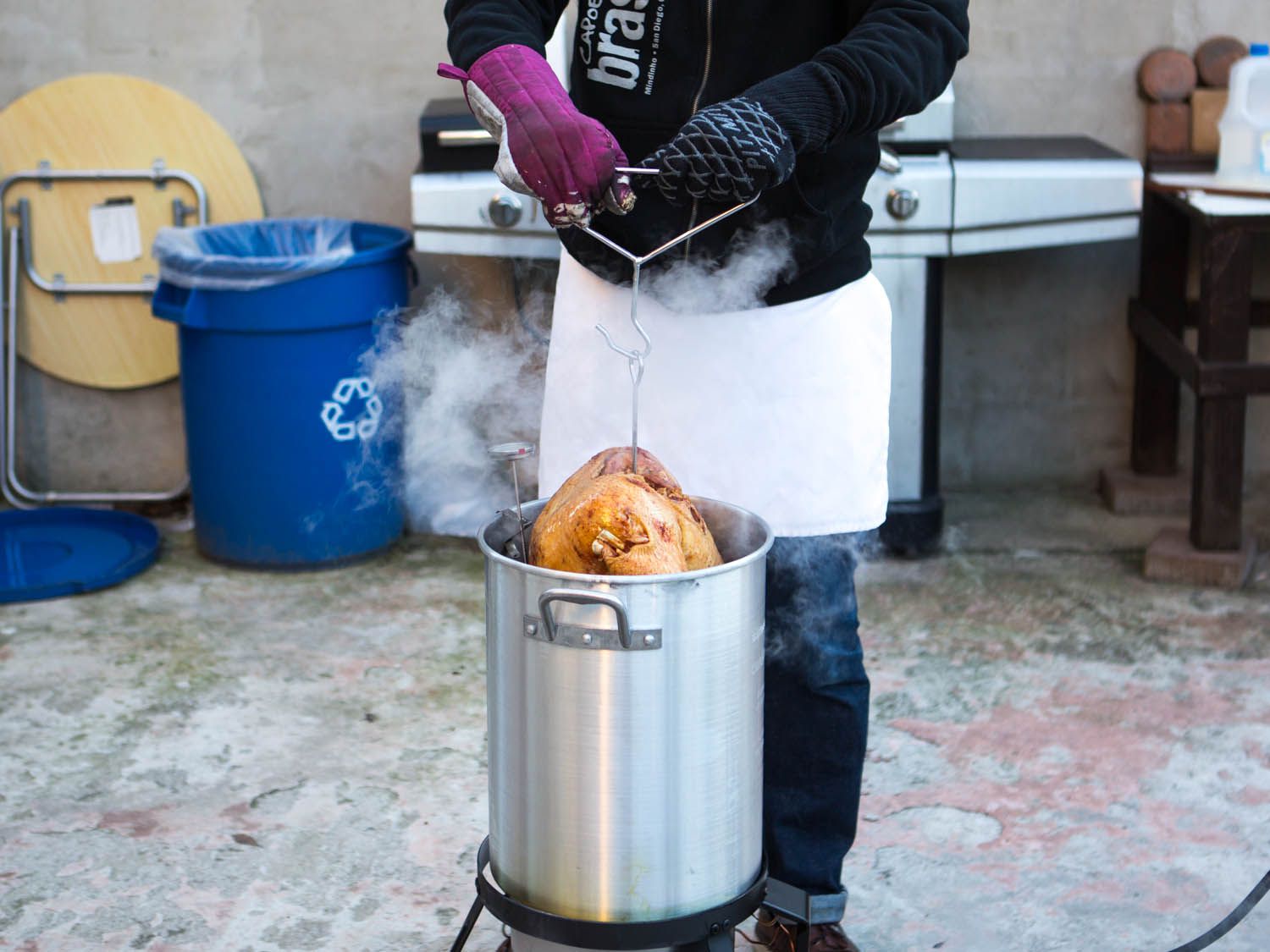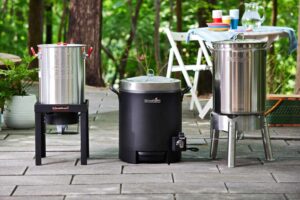Many people think using a turkey deep fryer is complicated and dangerous. But with the right tools and safety precautions, it’s actually a straightforward process that yields delicious results. Imagine a crispy, golden-brown turkey deep-fried to perfection, juicy on the inside – sounds amazing, right? Let’s dive into the world of turkey deep fryers and discover why this method is gaining popularity.
Using a turkey deep fryer isn’t just for Thanksgiving; it’s a fantastic way to cook a flavorful bird any time of the year. It’s faster than traditional roasting, meaning you spend less time cooking and more time enjoying your meal. Plus, the crispy skin and juicy meat are unbeatable. However, to achieve these mouth-watering results, it’s crucial to use the right equipment and follow safety guidelines. So, let’s start with the basics.

Why Choose a Turkey Deep Fryer?
You might wonder, why go for a turkey deep fryer instead of the conventional oven method?
Here are some compelling reasons:
Faster Cooking Time:
A turkey deep fryer can cook your bird in a fraction of the time it takes to roast it. Instead of hours in the oven, you’re looking at about 3-4 minutes per pound. That’s a huge time saver!
Juicier Meat:
The rapid cooking process locks in the juices, making the turkey incredibly moist and flavorful. No more dry turkey!
Crispy Skin:
The high temperature of the oil ensures a perfectly crispy skin that you can’t get from oven roasting. It’s the best part, isn’t it?
TYPES OF TURKEY DEEP FRYER:
There are mainly two types: propane and electric.
Propane Turkey Fryers:
These are the traditional and most popular choice. They heat up quickly and can be used outdoors. Propane fryers are powerful and can handle larger turkeys. They’re perfect for those who want that authentic, deep-fried flavor.
Electric Turkey Fryers:
These are a bit more user-friendly and safer to use indoors. They’re great for smaller spaces and don’t require propane tanks. Electric fryers are convenient and easy to control, making them a good choice for beginners.
Choosing a turkey fryer isn’t just about speed and convenience. It’s also about achieving a perfect balance of crispy skin and juicy meat. The right fryer will make this process easy and enjoyable, turning you into the star of every meal.
Essential Equipment for Deep Frying a Turkey
A common misconception is that you need an array of complicated gadgets to deep fry a turkey. In reality, you only need a few essential items to get started. Let’s go through the must-have equipment for a successful deep frying experience.
1. Turkey Fryer Pot:
This is the main component of your deep frying setup. It needs to be large enough to fully submerge your turkey. Typically, a 30-quart pot works well for turkeys up to 20 pounds. Make sure it’s made of sturdy material like stainless steel or aluminum to withstand high temperatures.
2. Burner:
If you’re using a propane turkey fryer, you’ll need a reliable burner. The burner should provide consistent heat and be stable enough to hold the pot securely. Look for a model with a high BTU rating for efficient cooking.
3. Thermometer:
A crucial tool for deep frying is a good thermometer. You need to monitor the oil temperature closely to ensure your turkey cooks evenly. An oil thermometer that clips to the side of the pot is ideal.
4. Fryer Basket or Hook:
To safely lower and lift the turkey from the hot oil, you’ll need a fryer basket or hook. The basket is easier for beginners, while experienced fryers might prefer a hook. Either way, it should be sturdy and have a comfortable handle.
5. Propane Tank:
For propane fryers, a propane tank is essential. Make sure it’s filled and ready to go. Always have an extra tank on hand, just in case.
6. Fire Extinguisher:
Safety first! Always keep a fire extinguisher nearby when deep frying. Make sure it’s rated for oil fires. This is non-negotiable.
7. Protective Gear:
Wearing protective gear like heat-resistant gloves and goggles can prevent burns from hot oil splashes. Long sleeves and pants are also a good idea.
Having the right equipment ensures a smooth and safe deep frying process. With these essentials, you’re ready to prep your turkey for frying. Let’s move on to how to prepare your turkey.
Preparing Your Turkey for Deep Frying
Contrary to popular belief, preparing a turkey for deep frying isn’t complicated or time-consuming. With a few simple steps, you can get your bird ready for the fryer and ensure it’s packed with flavor.
1. Thaw Your Turkey Completely:
Make sure your turkey is completely thawed before frying. Any ice or water can cause dangerous oil splatters. Plan ahead, as it can take several days to thaw a large turkey in the refrigerator.
2. Remove Giblets and Neck:
Check the cavity of the turkey and remove any giblets and the neck. These are often stored in a bag inside the bird. Save them for gravy or discard them.
3. Pat Dry:
After thawing, pat the turkey dry with paper towels. Removing excess moisture reduces the risk of oil splatters when you lower the turkey into the fryer.
4. Season the Turkey:
Seasoning is key to a flavorful turkey. Rub the turkey with a mixture of salt, pepper, and your favorite spices. You can also inject marinade into the turkey using a meat injector. Focus on the breast, thighs, and legs for maximum flavor.
5. Truss the Turkey:
Trussing means tying the legs and wings close to the body. This helps the turkey cook evenly and makes it easier to handle. Use kitchen twine to secure the legs and wings.
6. Preheat the Oil:
Start heating the oil in your fryer pot. The ideal temperature for deep frying a turkey is 350°F. Use your thermometer to monitor the temperature. This step is crucial for even cooking.
7. Lower the Turkey Slowly:
When the oil reaches the right temperature, slowly lower the turkey into the pot using the fryer basket or hook. Doing this slowly helps prevent oil from overflowing and splashing.
By following these steps, you ensure your turkey is well-prepared for the fryer. The key is to be thorough and careful, especially when handling the hot oil. In the next sections, we’ll dive into the actual frying process and how to stay safe while cooking.
Setting Up Your Turkey Deep Fryer and The Deep Frying Process
Setting Up Your Turkey Deep Fryer
A common misconception about deep frying a turkey is that it’s dangerous and overly complicated. While it’s true that safety is paramount, setting up your turkey deep fryer is straightforward with the right approach. The key is to follow a few essential steps and take necessary precautions to ensure a smooth and safe frying experience.
How to Set Up the Fryer Outdoors
First things first, always set up your turkey fryer outdoors. Using it indoors or in a garage is a big no-no due to the risk of fire and the release of harmful fumes. Choose a flat, stable surface away from any structures, trees, or anything flammable. This helps prevent accidents and ensures your fryer stays steady during the cooking process.
Safety Measures to Prevent Accidents
Safety is crucial when deep frying a turkey. Here are some essential safety measures to keep in mind:
- Read the Instructions: Before you start, read the manufacturer’s instructions for your specific turkey fryer model.
- Check for Leaks: If you’re using a propane fryer, inspect the propane tank and hose for any leaks before igniting.
- Use a Turkey Fryer Stand: Ensure your fryer is securely placed on a turkey fryer stand or a heat-resistant surface.
- Keep a Fire Extinguisher Nearby: Always have a fire extinguisher rated for grease fires within reach, just in case.
- Never Leave the Fryer Unattended: Once you start the frying process, stay close by and keep an eye on the fryer at all times.
By following these setup and safety tips, you can minimize risks and focus on achieving a perfectly fried turkey.
The Deep Frying Process
Deep frying a turkey might seem daunting, but with careful attention to detail, it’s a breeze. Here’s a step-by-step guide to help you through the process.
Detailed Instructions on Heating the Oil
First, fill your fryer pot with oil, ensuring you don’t exceed the maximum fill line. Peanut oil is a popular choice due to its high smoke point and neutral flavor. Light your propane burner or turn on your electric fryer, and heat the oil to 350 degrees Fahrenheit. Use a deep fryer thermometer to monitor the oil temperature accurately.
How to Safely Lower the Turkey into the Oil
Before lowering the turkey, make sure it’s completely thawed and dry to prevent dangerous oil splatters. Slowly and carefully lower the turkey into the hot oil using the fryer basket or a sturdy hook. This step is crucial; do it too quickly, and the oil might overflow, causing burns or fires.
Monitoring Oil Temperature and Cooking Time
Once the turkey is safely in the oil, maintain the temperature at 350 degrees Fahrenheit. It’s essential to monitor the temperature throughout the cooking process. A general rule of thumb is to fry the turkey for about 3 to 4 minutes per pound. So, for a 12-pound turkey, you’re looking at roughly 36 to 48 minutes.
Periodically check the oil temperature to ensure it remains consistent. If the temperature drops too low, the turkey will absorb excess oil and become greasy. If it gets too high, you risk burning the turkey. Use a meat thermometer to check the turkey’s internal temperature. It should reach 165 degrees Fahrenheit in the thickest part of the breast.
Safety Tips for Deep Frying a Turkey
While deep frying a turkey delivers delicious results, safety must always come first. Here are some additional safety tips to help you avoid accidents and ensure a successful frying experience.
Importance of Safety
Deep frying involves hot oil, which can be hazardous if not handled properly. Understanding the risks and taking precautions can prevent injuries and accidents. Always prioritize safety when setting up and operating your turkey fryer.
Tips to Avoid Accidents
- Proper Setup: Ensure your fryer is on a stable, non-flammable surface. Avoid using it on wooden decks or near any flammable materials.
- Fire Extinguisher Nearby: Always have a fire extinguisher suitable for grease fires within arm’s reach.
- Careful Handling: Handle the turkey and fryer basket with care. Use long, heat-resistant gloves to protect your hands from splashes and burns.
- Slow and Steady: When lowering the turkey into the oil, do it slowly to avoid oil overflow and splatters.
- Monitor Constantly: Keep a close watch on the fryer throughout the cooking process. Never leave it unattended.
By adhering to these safety guidelines, you can enjoy the process of deep frying a turkey without any mishaps.
In summary, setting up your turkey deep fryer and managing the deep frying process is manageable with the right preparation and attention to safety. Enjoy the delicious, crispy results and make your next holiday meal a memorable one.
Cleaning and Maintaining Your Turkey Deep Fryer
A common belief is that cleaning a turkey deep fryer is a huge hassle, but it’s actually quite simple if you follow a few straightforward steps. Keeping your fryer clean and well-maintained not only prolongs its lifespan but also ensures safe and efficient frying.
Step-by-Step Guide to Cleaning the Fryer
After you’ve enjoyed your delicious deep-fried turkey, it’s time to clean up. First, let the oil cool completely. Once it’s cool, strain it through a fine mesh strainer or cheesecloth to remove any food particles. Store the filtered oil in a clean, airtight container if you plan to reuse it.
Next, disassemble your fryer according to the manufacturer’s instructions. Wash the fryer pot, basket, and other removable parts with warm, soapy water. Use a soft brush to scrub off any stuck-on bits. Avoid using abrasive cleaners or steel wool as they can damage the surfaces.
For electric fryers, wipe down the heating element and control panel with a damp cloth. Make sure all components are thoroughly dry before reassembling and storing your fryer.
Tips for Maintaining and Storing Your Equipment
Proper maintenance is key to keeping your turkey deep fryer in top condition. Here are some tips:
- Regular Inspections: Check for any signs of wear and tear, especially on hoses and connections for propane fryers.
- Oil Storage: Store used oil in a cool, dark place and make sure it’s properly sealed to prevent contamination.
- Protective Covers: Use a cover to protect your fryer from dust and debris when not in use.
- Follow Manufacturer’s Guidelines: Always refer to the manufacturer’s instructions for specific maintenance tips and safety precautions.
By following these steps, you can ensure that your turkey deep fryer remains clean, safe, and ready for your next culinary adventure.
Choosing the Best Turkey Deep Fryer
Many people think that all turkey deep fryers are the same, but there are significant differences that can impact your frying experience. Choosing the right fryer can make all the difference in achieving the perfect deep-fried turkey.
Compare Electric vs. Propane Fryers
When it comes to turkey fryers, you have two main options: electric and propane.
Electric Fryers:
These are known for their ease of use and safety. They typically come with built-in temperature controls and are suitable for indoor use. Electric fryers are perfect for those who prefer a more controlled cooking environment.
Propane Fryers:
Propane fryers offer more power and can heat oil faster than electric models. They are usually used outdoors and are ideal for those who enjoy a more traditional frying experience. Propane fryers can handle larger turkeys and are great for big gatherings.
List of Top-Rated Models for 2025
Here are some of the best turkey deep fryers for 2025:
Bayou Classic 4225 42-qt Aluminum Turkey Fryer
This propane fryer is known for its large capacity and durability.
Masterbuilt MB23011615 Butterball XL Electric Fryer:
An excellent electric option with a spacious capacity and easy-to-use features.
Char-Broil Big Easy Oil-Less Liquid Propane Turkey Fryer:
A unique propane fryer that eliminates the need for oil, making it a healthier choice.
These models have received high praise for their performance, safety features, and ease of use. Whether you choose an electric or propane fryer, these top-rated options ensure a great frying experience.
Conclusion
To wrap things up, using a turkey deep fryer can transform your holiday meals with deliciously juicy meat and crispy skin. With the right fryer and proper technique, deep frying a turkey is not only safe but also a fun and rewarding process. Remember, safety and maintenance are key to a successful frying experience.
FAQs
Q: How long does it take to deep fry a turkey?
A: It usually takes about 3-4 minutes per pound to deep fry a turkey. So, a 15-pound turkey would take around 45-60 minutes.
Q: What kind of oil should I use?
A: Peanut oil is a popular choice because it has a high smoke point and adds great flavor. You can also use canola or vegetable oil.
Q: How do I know when the oil is at the right temperature?
A: Use a deep fryer thermometer to check the oil temperature. It should be around 350°F.
Q: Can I deep fry a frozen turkey?
A: No, never deep fry a frozen turkey. It can cause the oil to splatter violently, which is very dangerous.
Q: Do I need to marinate the turkey before frying?
A: Marinating isn’t necessary, but it adds flavor. You can use dry rubs or inject marinades for extra taste.
Q: How do I clean up after frying?
A: Let the oil cool completely before disposing of it. Use a funnel to pour it back into its original container for disposal or recycling. Clean the fryer pot and other equipment with warm, soapy water.
Q: Is it safe to deep fry a turkey indoors?
A: Only if you’re using an electric fryer designed for indoor use. Propane fryers should always be used outdoors.


